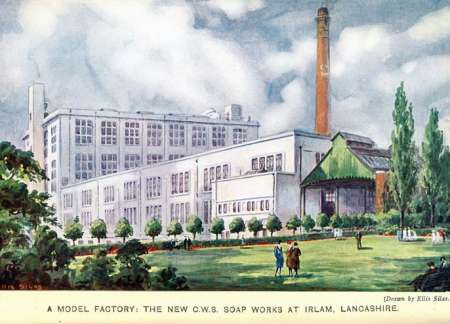CWS Soap and Candle Works, Irlam
A NEW SOAP WORKS. OPENED BY SIR W.E. DUDLEY, O.B.E., AT IRLAM. C.W.S. INDUSTRIAL DEVELOPMENT, INTERESTING TOUR OF A SPACIOUS BUILDING. A further stage in the industrial development of Irlam was reached on Tuesday by the opening of the Co-operative Wholesale Society's new soap works, which will find employment for 500 more operatives. The new building adjoins the old soap works opened at Irlam in 1895. Since the C.W.S. started manufacturing soap at Durham in 1874, a weekly output of seven tons has grown to one of 900 tons a week, and the new works is capable of an output of another 500 tons.
THE OPENING CEREMONY - The opening ceremony was performed by Sir William E. Dudley, O.B.E., chairman of the Grocery Committee, in the presence of representatives of 600 co-operative distributive societies from all parts of the northern area, which includes Lancashire, Cheshire and Yorkshire. "It is well and truly started," said Sir William as he formally opened the works by starting the machinery. Afterwards the visitors toured the new building and later were entertained to luncheon presided over by Mr. H.J.A. Wilkins, president of the Co-operative Wholesale Society, Ltd.
The new building, which is of reinforced concrete, has been designed for the health and comfort of employees. The departments are spacious, well lighted and compactly arranged. A novel feature is the inclusion in the main building of the caustic and glycerine departments usually housed in separate buildings on account of the somewhat untidy nature of waste products. This drawback has been successfully overcome by the well-balanced structure lending itself to more economical working and improved supervision and control. The third and top storey of the building accommodates the soap-boiling pans, each of which is capable of holding 60 tons of soap. There will eventually 16 of these pans, turning out a total of 500 tons of soap a week. The second floor contains the glycerine lye tanks and soap clutchers, and the ground floor is occupied by the soap frames, in which the soap is allowed to cool preparatory to the slabbing, barring, stamping and packing operations, conducted in the spacious stamp room.
All the machinery is of the latest type, and the power-house, with its two turbo-generators, is designed to provide the whole of the energy required for both the existing and the new soap works. The roof is laid out with plants, a fountain, and seats for the pleasure of the employees. Under the direction of Mr. H. Townley, the building has been erected by the C.W.S. Building Department, from designs by the late architect, Mr. F.E.L. Harris, and the power and steam raising equipment was installed by the C.W.S. Engineering Department, under the control of Mr. R.L. Gass, the engineer. [Cadishead and Irlam Guardian 1926]
Reference Manchester City News 31 July 1926 Page 9 Column 1 - opening
Reference Cadishead and Irlam Guardian 1926
Reference CWS People’s Yearbook 1927 frontispiece
Information Maurice Cullen by email January 2022
See also further extension to soap works 1934-1936 by CWS Architects Department
